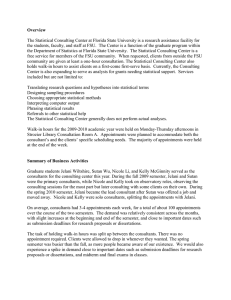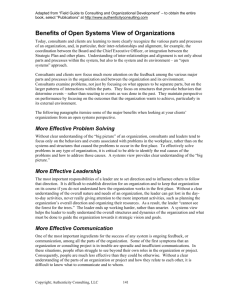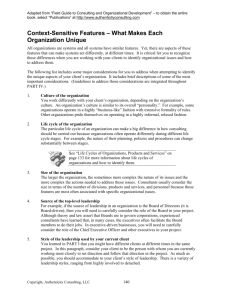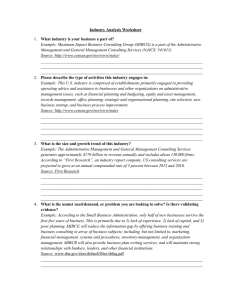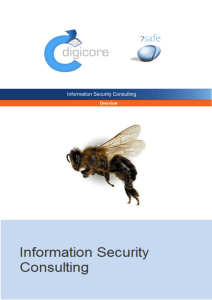consultreport2010 - Department of Statistics
advertisement
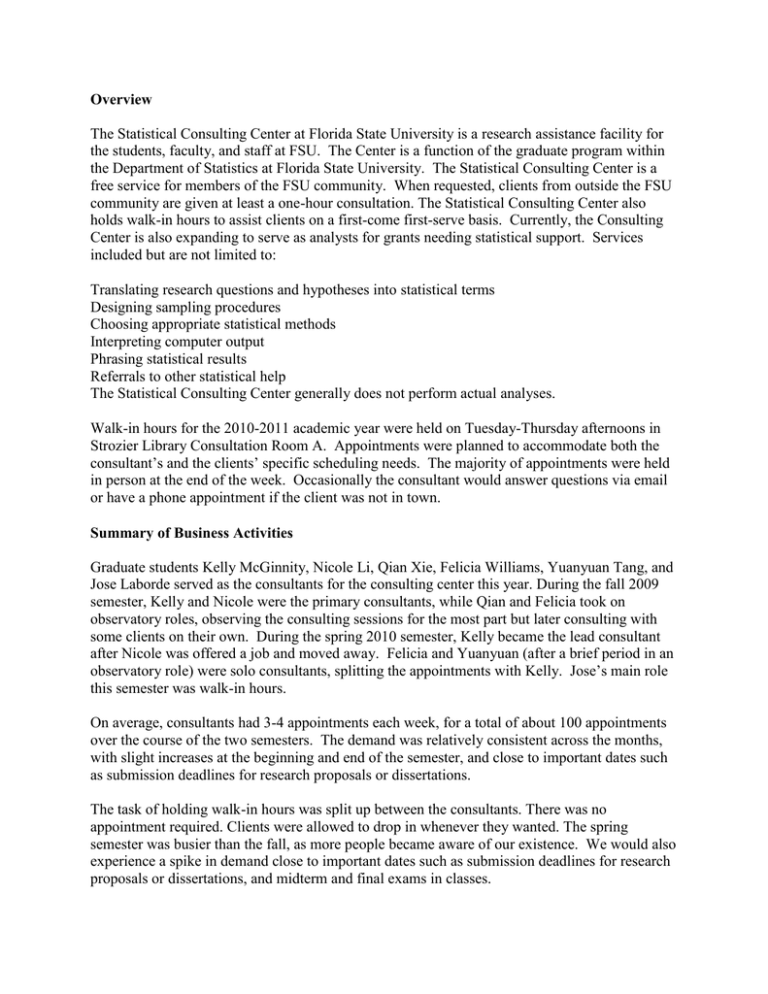
Overview The Statistical Consulting Center at Florida State University is a research assistance facility for the students, faculty, and staff at FSU. The Center is a function of the graduate program within the Department of Statistics at Florida State University. The Statistical Consulting Center is a free service for members of the FSU community. When requested, clients from outside the FSU community are given at least a one-hour consultation. The Statistical Consulting Center also holds walk-in hours to assist clients on a first-come first-serve basis. Currently, the Consulting Center is also expanding to serve as analysts for grants needing statistical support. Services included but are not limited to: Translating research questions and hypotheses into statistical terms Designing sampling procedures Choosing appropriate statistical methods Interpreting computer output Phrasing statistical results Referrals to other statistical help The Statistical Consulting Center generally does not perform actual analyses. Walk-in hours for the 2010-2011 academic year were held on Tuesday-Thursday afternoons in Strozier Library Consultation Room A. Appointments were planned to accommodate both the consultant’s and the clients’ specific scheduling needs. The majority of appointments were held in person at the end of the week. Occasionally the consultant would answer questions via email or have a phone appointment if the client was not in town. Summary of Business Activities Graduate students Kelly McGinnity, Nicole Li, Qian Xie, Felicia Williams, Yuanyuan Tang, and Jose Laborde served as the consultants for the consulting center this year. During the fall 2009 semester, Kelly and Nicole were the primary consultants, while Qian and Felicia took on observatory roles, observing the consulting sessions for the most part but later consulting with some clients on their own. During the spring 2010 semester, Kelly became the lead consultant after Nicole was offered a job and moved away. Felicia and Yuanyuan (after a brief period in an observatory role) were solo consultants, splitting the appointments with Kelly. Jose’s main role this semester was walk-in hours. On average, consultants had 3-4 appointments each week, for a total of about 100 appointments over the course of the two semesters. The demand was relatively consistent across the months, with slight increases at the beginning and end of the semester, and close to important dates such as submission deadlines for research proposals or dissertations. The task of holding walk-in hours was split up between the consultants. There was no appointment required. Clients were allowed to drop in whenever they wanted. The spring semester was busier than the fall, as more people became aware of our existence. We would also experience a spike in demand close to important dates such as submission deadlines for research proposals or dissertations, and midterm and final exams in classes. Appointment Summary PIE CHART Appointment Schedule by Client Type 16% Clients with 1 meeting Clients with 2 meetings 13% Clients with 3 or more meetings 71% The majority of appointment clients this year were Doctoral students seeking assistance for the quantitative aspect of their dissertations. We also met with some Masters and Undergraduate students writing a thesis, working on a research project, or studying for a class. On a few occasions, faculty members were provided statistical advice for their research work. Over time, we are proud to say that we have been able to provide statistical services for clients from various departments of the University community as indicated below: Anthropology Art Education Biology Chemistry Communication Disorders Dance Engineering Exercise Science Educational Psychology and Learning Systems Department Family and Child Sciences Family and Consumer Sciences Fashion Design General Education Instructional Systems Mathematics Education Meteorology Music Education Music Therapy Nursing Nutrition Oceanography Physical Education Physics Psychology Public Administration Public Health Social Work Sociology Sports Management and Recreation Management Textiles and Consumer Sciences Initial consultations and follow-up appointments were scheduled throughout the clients’ research processes until the completion of the statistical research. The most frequent statistical ideas used were t-tests, ANOVA, basic linear regression, logistic regression, Chi-square, factor analysis, power analysis, sample size calculations, and survey data analysis. The consulting center is currently able to advise clients as to the functions of computer packages such as SPSS, SAS, and Excel, but does not perform a client’s actual analysis. Typical Cases In fall of 2010, a graduate student from FSU’s college of education who was working on her dissertation, was in need of help with determining if two sections of college students in the same course performed differently due to pedagogical changes. Here, performance was evaluated based on responses from in-class questions. Question difficulty differed between questions. Questions were grouped into two levels: a higher level and a lower level. Performance difference due to question difficulty was of interest as well. The student was using a repeated measure method of analysis because there was more than one response variable. The consultant pointed out that a repeated measure method was not necessary. It was suggested that, instead, it could be treated as a two single response variable problem, then the results from each analysis could be compared to evaluate the difference of responses from different levels of questions. It was also suggested that the data be rearranged in order to perform the analysis. An indicator variable was added for question difficulty level. SPSS was used for the analysis. In spring of 2011, a graduate student from the Anthropology Department at FSU, came to us for help with his dissertation. The student had data from an archeological dig from 4 different sites. He wanted to perform a cluster analysis in SPSS as well as determine a heterogeneity measure for diversity and determine how to create dendro charts. The student was not very familiar with SPSS and the consultants provided the student with various websites for learning the software as well as assisted the student in importing his data into the software package. The consultants provided alternative, simpler methods to assist the student with his initial problem such as performing a MANOVA. Upon analysis of his data using the MANOVA, the student wanted a good way to graphically display the significant variation between sites for multiple dependent variables. The consultants suggested using comparative boxplots instead of using a cluster analysis. As for the heterogeneity test, the consultants showed the student how to obtain and output the values needed for the calculation within SPSS crosstabs. It was also suggested that the student acquire a heterogeneity statistic for each time period in his analysis for comparison. When a client contacts the Consulting Center at the beginning of the research process, the consultant is able to assist in every aspect of the statistical design of the study. Consultants can advise clients on how to determine proper sampling strategies and sizes, the collection of data, initial demographic analysis and interpretation of data, and specific statistical procedures to answer the desired research questions or meet the client’s research goals. Clients at each stage of this research process frequently contact the Consulting Center and are assisted until the completion of the statistical aspects of their research. Walk-in hours summary PIE CHART Walk-in Clients by Group 20% Help with Upper-Level Undergraduate Class Help with Graduate Class 15% 65% Help with Dissertation, Thesis, Research Project, etc. The majority of walk-in hours clients were looking for help in an upper-level undergraduate or graduate level statistics-related class at FSU. Many students were regular visitors to the consultation room and came to us for help with homework assignments and tests. Other clients were looking for assistance with their dissertations, theses, or research projects. Often this would involve advising them on running tests or interpreting output on computer programs such as SPSS. If the consultation room were extremely busy we would sometimes ask these clients to schedule an 1-on-1 appointment outside of walk-in hours so we could devote all of our attention to their research problem, rather than trying to jump back and forth to assist multiple clients in the room. This year, we are proud to say that we have been able to provide statistical services for clients in various statistics-related courses as indicated below: CCJ 5705 – Research Methods in Criminology I ECO 4421 – Introduction to Econometrics ECO 4431 – Introduction to Economic Forecasting EDF 5400 – Basic Descriptive and Inferential Statistics Applications GEO 4185 – Spatial Data Analysis LIN 5932 – Research Methods NUR 3822 – Professionalism and Research in Nursing MAR 3023 – Basic Marketing Concepts PAD 5701 – Quantitative Analysis PAD 6705 – Analytical Tech for Public Administration POS 3713 – Political Science Research POS 5737 – Political Science Data Analysis PSY 6919 – Design and Analysis in Psychology STA 2171 – Statistics for Biology STA 3024 – SAS Data and Stat Analysis STA 3032 – Probability and Statistics for Science and Engineering STA 4322 – Mathematical Statistics STA 4202/5602 – ANOVA and Design of Experiments STA 4203/5207 – Applied Regression Analysis STA 4321 – Intro to Mathematical Statistics STA 4853 – Time series and Forecasting Methods STA 5066 – Data Management and Analysis with SAS STA 5172 – Statistics for Epidemiology Reflections Once again, working in the Statistical Consulting Center has allowed us the opportunity to see the wide variety of fields where the discipline of statistics can be useful. From the perspective of a graduate student in Statistics, the Center is an opportunity to take what we have learned in the classroom and apply them to the real world problems. It has also been rewarding to know that in some small way we have been able to help so many different people in this collaborative research process.
